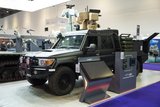Harris awarded $16m contract by Lockheed Martin
Harris Corporation, an international communications and information technology company, has been awarded a $16 million follow-on contract by Lockheed Martin to supply more than 100 Harris Highband Networking Radio systems for the US Army's Warfighter Information Network - Tactical (WIN-T) Increment 2 program. The contract represents the largest-quantity radio order to date, and brings the total value of WIN-T contracts to Harris to more than $200M since 2002.
The Harris Highband Networking Radio (HNR) features the first-ever use of directive beam technology to achieve higher throughput over longer distances. The HNR hosts the Harris-developed Highband Networking Waveform (HNW), which enables automatic selection of the best communications path, and creates a self-forming, self-healing network. Nodes can enter and exit without the need for fixed network infrastructure or operator intervention. In addition to its use in WIN-T Increment 2, an advanced version of the HNW will run on WIN-T Increment 3 hardware platforms.
The HNR has been implemented in the WIN-T Increment 2 program as a terrestrial, line-of-sight layer in an integrated communications architecture. This terrestrial layer includes mobile and fixed nodes and augments a celestial layer supporting satellite communications for beyond line-of-sight connectivity.
"The HNR is designed from the ground up to support the networked battlefield and to ensure that warfighter have a trusted, yet mobile, communications backbone," said Sheldon Fox, group president, Harris Government Communications Systems. "This follow-on contract represents our continuing commitment to meeting the requirements of the WIN-T program and advancing the communications technology of the US Army."
Source: Harris Corporation
More from Digital Battlespace
-
![Babcock nears first customer for Nomad AI translation tool]()
Babcock nears first customer for Nomad AI translation tool
Nomad can provide militaries with real-time intelligence, saving critical time on the battlefield.
-
![AUSA 2025: Israel’s Asio Technologies to supply hundreds of improved Taurus tactical systems]()
AUSA 2025: Israel’s Asio Technologies to supply hundreds of improved Taurus tactical systems
Taurus operates alongside the Israel Defense Forces’ Orion system which supports mission management across tens of thousands of manoeuvring forces, from squad leaders to battalion commanders.
-
![AUSA 2025: Kopin pushes micro-LED plans as China moves faster]()
AUSA 2025: Kopin pushes micro-LED plans as China moves faster
The plan for the new displays follows fresh investment in Kopin’s European facilities by Theon and an order for head-up displays in fielded aircraft, with funding from the US Department of Defense.
-
![AUSA 2025: Persistent Systems to complete its largest order by year’s end]()
AUSA 2025: Persistent Systems to complete its largest order by year’s end
Persistent Systems received its largest ever single order for its MPU5 devices and other systems earlier this month and has already delivered the 50 units to the US Army’s 4th Infantry Division.
-
![Aselsan brings in dozens of companies and systems under the Steel Dome umbrella]()
Aselsan brings in dozens of companies and systems under the Steel Dome umbrella
Turkey has joined the family of countries attempting to establish a multilayered air defence system with government approval in August 2024 for the effort landed by Aselsan. Dubbed Steel Dome, the programme joins Israel’s Iron Dome, the US Golden Dome, India’s Mission Sudarshan Chakra and South Korea’s low-altitude missile defence system.
-
![DSEI 2025: MARSS unveils new agnostic multidomain C4 system]()
DSEI 2025: MARSS unveils new agnostic multidomain C4 system
MARSS’ NiDAR system has been deployed using sensors from static platforms to provide detection and protection for static sights, such as critical infrastructure, ports and military bases.



























